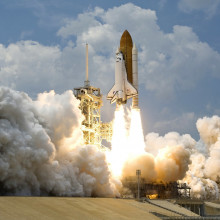Could a space rocket be launched from a gun?
Anthony wanted to know if firing space rockets out of giant guns would be a better way to blast off. Heather Wark spoke to Dr Stuart Grey of Strathclyde University to find out...
In this episode

00:00 - Do rockets launched from tubes travel faster?
Do rockets launched from tubes travel faster?
Heather - We fired off Anthony’s question to Dr. Stuart Gray, Researcher and Lecturer in Aerospace Engineering at Strathclyde University..
Stuart - Whether we want to send a spacecraft close to the Earth or much further afield we need to start by going into an orbit. This is because using an orbit or a series of orbits, it’s far more fuel efficient than blasting straight for our destination. This is because we are working with the gravity of Earth rather than against it.
The particularly hard part about getting into an orbit is not getting to a high enough altitude, but getting to a high enough speed. For any given altitude there is a specific speed that must be achieved in order for an object to avoid falling back to Earth. For low Earth orbit, this is about 7 kilometres per second, or 16,000 miles per hour.
Heather - That’s pretty fast! Most bullets only travel at 1 kilometre per second. That’s not even close to 7, but what if we made a really powerful gun?
Stuart - Firing an object from a tube or gun is a good way to get an object moving very quickly as all the explosive energy is contained within the barrel and is used to accelerate the object along the barrel. For getting into orbit though, even a very large gun would struggle to get an object up to the velocities required.
Even if your gun could fire an object fast enough, another issue is that as soon as the object leaves the barrel of a gun there’s not longer any force from the propellant, and from there on out the object slows down. A rocket, on the other hand, is constantly accelerating as it carries all of its own fuel and burns it as it goes.
Ignition sequence starts… 3, 2, 1, 0… all engines running. Lift off, we have lift off.
Heater - Right. So bullets start off fast and then slow down. Whereas rockets start of slow and then speed up. Could we combine the two and fire a rocket out of a giant gun before turning on the engines so that it starts fast and keeps getting faster?
Stuart - We struggle to reach very high speeds at sea level because we have to push through the air. Rockets spend the first portion of their flight gaining altitude to get above the very thick layer of atmosphere before picking up speed where the atmosphere is much thinner. If our rocket was too fast at low altitudes, the drag forces would be extreme and break the rocket apart.
If we were to launch our rocket from the barrel of a gun, we could imagine that we would get some boost in initial velocity. This wouldn’t be any real help as the rocket would experience lots of extra drag as it exited the barrel. Overall, any small benefit in initial velocity for our rocket from launching from a tube would be outweighed by the engineering costs of ensuring it didn’t rip itself apart due to the drag forces caused from travelling very fast at low altitudes.
Heather - Mmm. Not sure our astronauts would thank us for that… good to know. Thanks Stuart.
Next week we’ll be fishing for an answer to this marine musing from the Waite family:
Hello Naked Scientists. We’ve just added a puppy to our family and we noticed that he yawns a lot. While we were watching Blue Planet II this week, that got us wondering… Do fish yawn - is there an aquatic equivalent?










Comments
from a non-scientific and
from a non-scientific and technical point of view, perhaps, if we associate the idea with a handgun projectile such as a pistol, for example, the projectile launched achieves an incredibly fast displacement speed based on three basic factors, the explosion of the fuze that activates the powder in the cartridge, of the spiral grooves drawn inside the barrel where the bullet will go and the specific weight of the projectile the set of these three factors brings the result. In the case of a larger artifact such as a rocket, for example, everything changes, so that a sufficiently strong explosion is able to displace the mass of the artifact into the tube, to travel through the spiral grooves necessary to implement the accelerated spin of the rocket without which it would not be possible to cut the air for a better evolution, and finally to know how to deal with the friction of the artifact within everything that will slow the advancement of the artifact, which currently does not occur with the conventional launches, even spoke in nuclear propulsion, this sum equivalent to tons of tnt could yes launch the projectile towards space, but at what cost, and at what risk if this technology was ever tested?
Add a comment